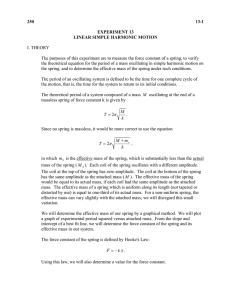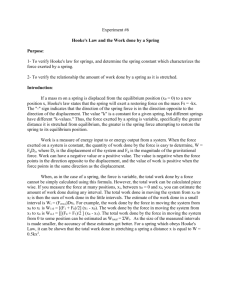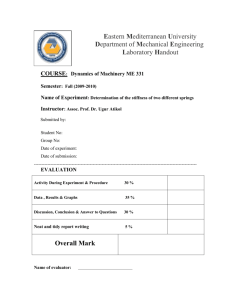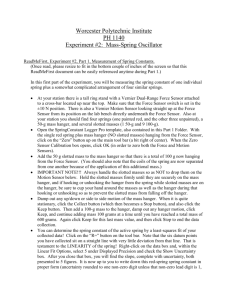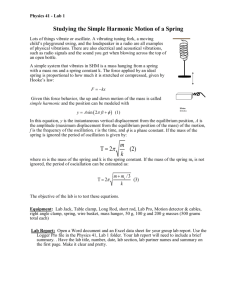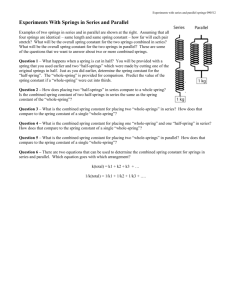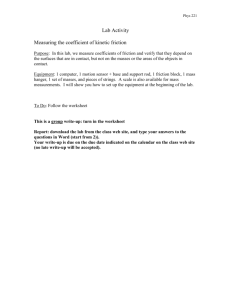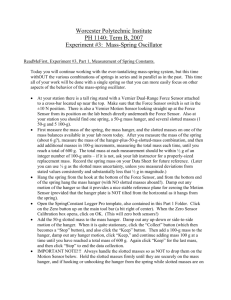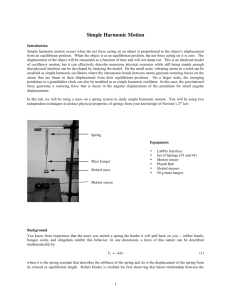Spring Forces Lab - prettygoodphysics
advertisement
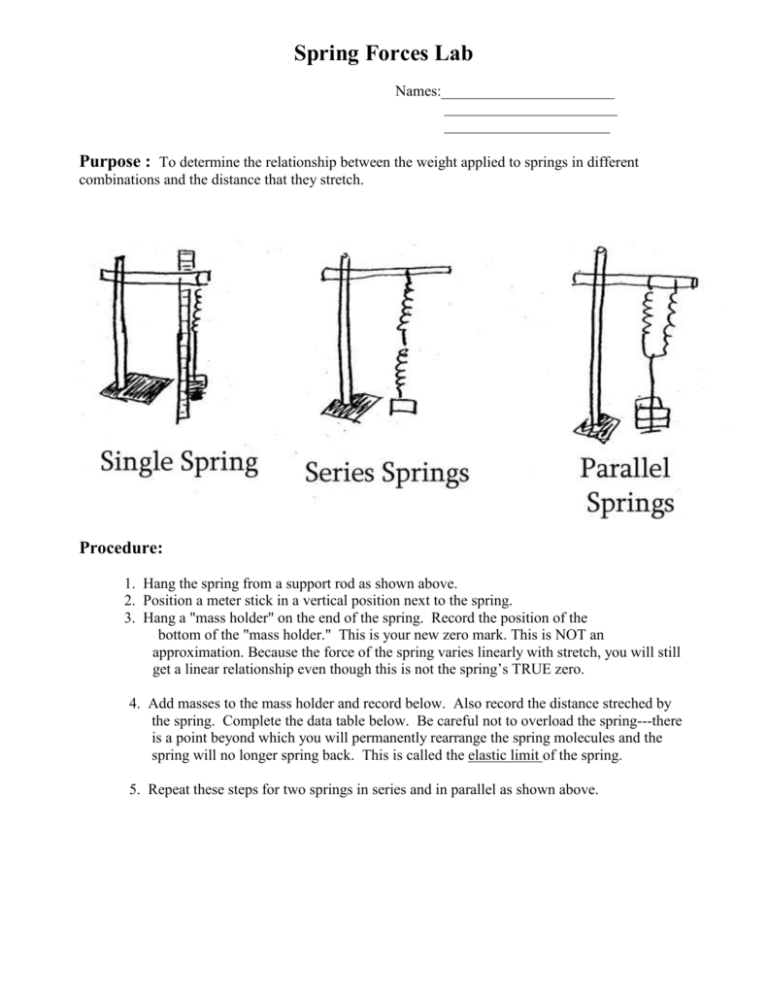
Spring Forces Lab Names:_______________________ _______________________ ______________________ Purpose : To determine the relationship between the weight applied to springs in different combinations and the distance that they stretch. Procedure: 1. Hang the spring from a support rod as shown above. 2. Position a meter stick in a vertical position next to the spring. 3. Hang a "mass holder" on the end of the spring. Record the position of the bottom of the "mass holder." This is your new zero mark. This is NOT an approximation. Because the force of the spring varies linearly with stretch, you will still get a linear relationship even though this is not the spring’s TRUE zero. 4. Add masses to the mass holder and record below. Also record the distance streched by the spring. Complete the data table below. Be careful not to overload the spring---there is a point beyond which you will permanently rearrange the spring molecules and the spring will no longer spring back. This is called the elastic limit of the spring. 5. Repeat these steps for two springs in series and in parallel as shown above. PARALLEL SPRING: Record “Zero” position with only the 50 g hanger: _________(meters!) X-axis Position of Mass Hanger (m) Spring Displacement (meters!!!!) 0 Y-axis Total Mass (kg) (not counting hanger) Force (Newtons) (W=mg) 0 SERIES SPRING: Record “Zero” position with only the 50 g hanger: _________(meters!) X-axis Position of Mass Hanger (m) Spring Displacement (meters!!!!) 0 Y-axis Total Mass (kg) (not counting hanger) Force (Newtons) (W=mg) 0 SINGLE SPRING: Record “Zero” position with only the 50 g hanger: _________(meters!) X-axis Position of Mass Hanger (m) Spring Displacement (meters!!!!) 0 Y-axis Total Mass (kg) (not counting hanger) Force (Newtons) (W=mg) 0 Analysis: SHOW ALL CALCULATIONS!!!!!!!! 1. Use Graphical Analysis to make a graph of Force vs. Displacement for each of the three experiments. Include all three graphs on one graph. Do not curve fit until all three lines are on the graph or you will lose the curve fit. Choose PROPORTIONAL, not LINEAR when curve-fitting to ensure that your curve goes through (0,0). 2. Since Hooke’s Law states that: F = - K (x), the slope of your line is the spring constant for each scenario. Record these values below. Spring Constant for single spring:_______________________ (don't forget units!) Spring Constant for two spring in series:______________________ Spring Constant for two spring in parallel:_____________________ 3. Which has a greater spring constant: a strong spring or a loose spring? Explain. 4. Calculate the ratio of: K parallel K sin gle __________________________. The theoretical value for this ratio is 2. Calculate your Percentage error: ________________________ ========================================================== Proof that the theoretical value is 2: a. Draw an FBD for a single mass, m, supported by a single spring of spring constant K. b. Calculate the amount by which the spring is stretched: X. c. Draw an FBD for a single mass, m, supported by two identical springs of spring constant K. d. Calculate the amount by which the springs are stretched (Don’t add the stretches, we want the total vertical displacement of the system.) Since K and X are inversely related, what does this tell you about the “effective” spring constant of two springs in parallel? “Effective spring constant” means if you treat the spring system as a single spring, what is the value of its spring constant. e. How much of the total weight does each spring support? 5. Calculate the ratio of: K series K sin gle __________________________. The theoretical value for this ratio is .5. Calculate your Percentage error: ________________________ Proof that the theoretical value is 1/2: a. Draw an FBD for a single mass, m, supported in series two identical springs of spring constant K. This FBD is a little more tricky. Draw an FBD for the hanging mass and isolate the forces acting solely on that mass. Calculate the amount by which the lower spring stretches. b. Based on your diagram above, what is the total vertical stretch of the series spring system? Since K and X are inversely related, what does this tell you about the “effective” spring constant of two springs in series? “Effective spring constant” means if you treat the spring system as a single spring, what is the value of its spring constant. c. How much of the total weight does each spring support? 7. Ms. Groppe has a long spring with a spring constant of 36 N/m and cuts it into three identical pieces. What will be the spring constant of any one of the three smaller springs? Justify your answer based on the results of the lab, force diagrams, etc. 8. Based on the lab, which of the following statements is true? (only one) a. As you add identical coils to a spring, the spring constant remains unchanged—the shape of an individual coil determines the spring constant—so adding more doesn’t change anything. b. As you add identical coils to a spring, the spring gets stronger—because there are more coils to push or pull. c. As you add identical coils to a spring, the spring gets more loose—because it actually creates “give” which reduces the spring constant.

